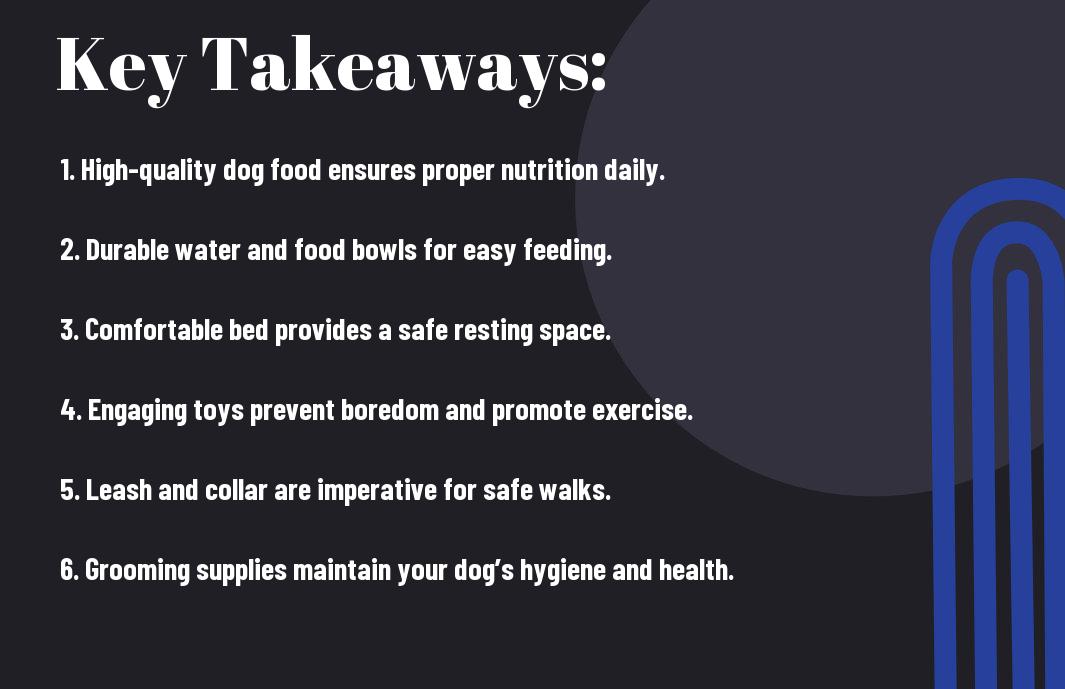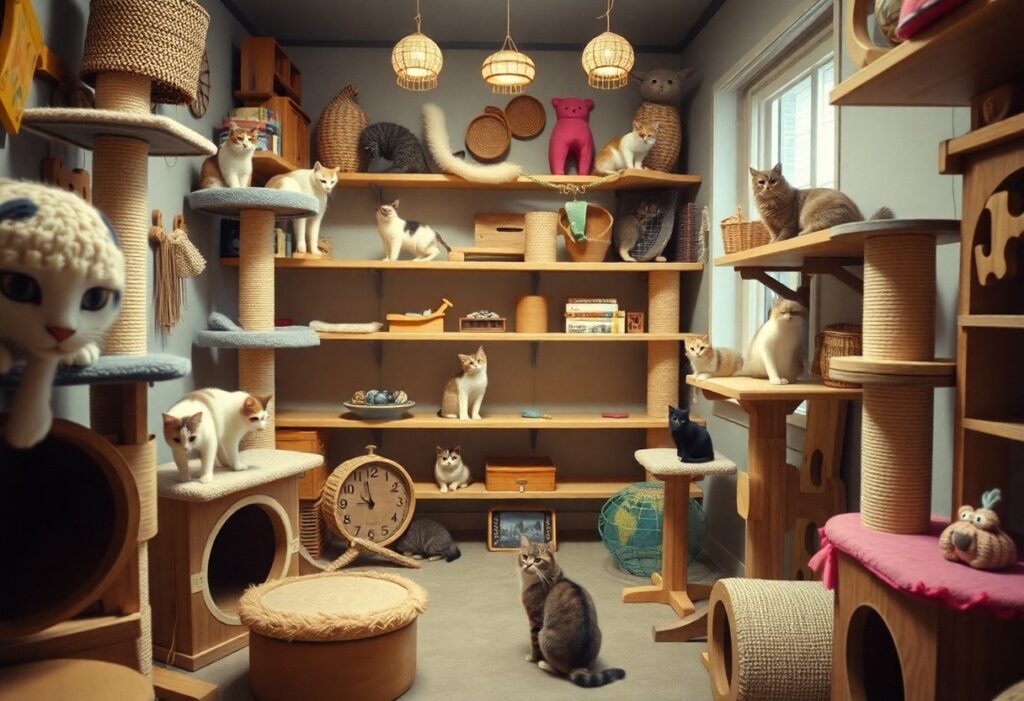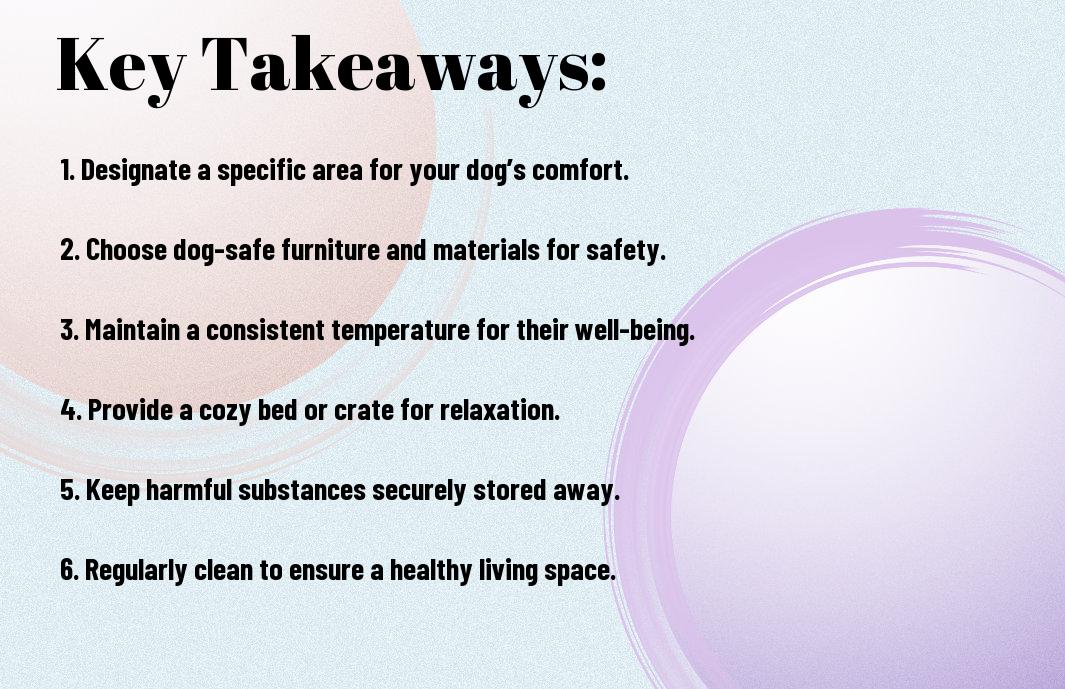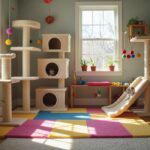Many pet owners overlook the importance of creating a safe and comfortable environment for their dogs. By focusing on removing hazards, such as toxic plants and sharp objects, you can significantly enhance your dog’s safety. Additionally, providing a designated comfortable space with cozy bedding and familiar toys helps your dog feel secure and happy. Implementing these vital tips not only protects your furry friend but also fosters a positive atmosphere that strengthens your bond. In this blog post, we’ll research into practical steps to ensure your home is a haven for your canine companion.

Understanding Your Dog’s Needs
Your dog’s wellbeing is a direct reflection of how well you can cater to its needs. Understanding these needs is necessary for creating a safe and comfortable environment. By ensuring that your dog’s basic psychological, physical, and behavioral requirements are met, you can significantly enhance its quality of life.
Basic Psychological Needs
Before you can truly create a nurturing space for your dog, you must understand its psychological needs. Dogs thrive on consistency, routine, and companionship. A structured environment helps your dog feel secure and reduces anxiety. Regular interaction, whether through play or simple companionship, fulfills their need for socialization, which is necessary for their mental health.
Moreover, providing mental stimulation through toys, puzzles, and training exercises is vital for keeping your dog engaged. Boredom can lead to misbehavior or destructive tendencies, so it is your responsibility to ensure that your furry friend remains mentally active. Incorporating a mix of activities into your dog’s routine will foster a happy and confident canine.
Physical Requirements
Dogs require specific physical needs to maintain their health and happiness. They need access to a clean, safe space to move around, as well as proper nutrition and regular exercise. Regular walks and playtime not only contribute to their physical fitness but also play a significant role in behavioral moderation. A tired dog is often a well-behaved dog, so implementing a daily exercise routine is beneficial.
At the core of your dog’s physical needs is their access to clean water and a balanced diet tailored to their breed and life stage. This ensures they have the energy to play and engage in daily activities while also maintaining a healthy weight. Regular veterinary check-ups are also necessary to identify any potential health issues early on.
Behavioral Considerations
Between understanding your dog’s physical requirements and meeting its behavioral needs lies the essence of a harmonious home. Dogs are social animals that thrive on interaction. Providing them with ample opportunities to socialize with other pets and people can help prevent anxiety and aggression issues. Creating a balanced routine that’s rich in socialization, play, and training can therefore lead to more desirable behavior.
Due to various factors such as breed characteristics, age, and past experiences, some dogs may require special attention to their behavioral needs. For example, if you have a timid dog, exposing it gradually to new environments and experiences can build its confidence. Alternatively, energetic breeds might need more vigorous activities to prevent restlessness. Tailoring your approach to address these unique behaviors will ensure your dog not only feels safe but also emotionally fulfilled in its home.

Choosing the Right Space
One of the most important aspects of creating a safe and comfortable home for your dog is choosing the right spaces. Dogs are natural creatures of habit, and they thrive in environments that cater to their needs. By examining your home layout and adapting it to accommodate your furry friend, you can enhance their comfort and well-being while minimizing potential risks.
Indoor Areas for Comfort
Areas designed for your dog’s comfort should focus on providing cozy resting spots, as well as easy access to food and water. Consider placing a comfortable bed in a quiet corner where your dog can retreat whenever they need a break. Including a few soft blankets can elevate their sleeping experience and provide additional warmth during cooler months.
Be sure to set up a designated area where your dog can easily access their food and water bowls. This area should be away from high-traffic zones to prevent spills and disturbances during mealtimes. Adding a non-slip mat can help keep bowls in place and create a dedicated space for your dog’s nourishment.
Outdoor Spaces for Exploration
Above all, your dog needs access to outdoor spaces that encourage exploration and physical activity. A securely fenced yard can offer a safe environment for your dog to run, play, and discover their surroundings. Ensuring the fence is tall enough and free from gaps will help keep your dog secure while they enjoy the fresh air and sunshine.
The outdoor area should also include features like shaded spots for cooling off, as well as toys to keep your dog engaged. Incorporating different textures on your yard, such as grass, gravel, or dirt, provides enrichment through varied surfaces that they can investigate while keeping their curiosity alive. Just like in indoor areas, a positive environment outdoors fosters your dog’s happiness and well-being.
Safety Features for Dogs
To ensure that your home is a safe haven for your dog, implement various safety features both indoors and outdoors. Inside your home, be mindful of keeping toxic plants, hazardous cleaning supplies, and electrical cords out of reach. It’s wise to securely store away any items that could pose a choking hazard or potential injury.
Additionally, in outdoor settings, make sure there are no sharp objects or potentially harmful chemicals lying around. Consider investing in items like secure latches on gates and safety nets for windows or balconies to prevent any accidents. These simple measures contribute significantly to the safety of your furry companion.
Also, evaluate your living space for potential escape routes your dog might find. Ensuring that all exits are secure and consistently checking your fencing for weaknesses can save you from losing your beloved pet or preventing unwanted encounters with other animals.
Creating a Safe Environment
All dogs deserve a home that prioritizes their safety and comfort. By taking the right steps, you can create a space where your furry friend feels at ease and protected. It’s necessary to identify potential hazards and remove them, ensuring your dog can roam freely without danger lurking at every corner.
Hazards to Avoid in the Home
With the right precautions, you can limit your dog’s exposure to household dangers. Common hazards include items like electrical cords, small objects they could swallow, and toxic plants. Make it a habit to secure trash cans, as discarded food items can pose a significant health risk if ingested. Additionally, chemicals that you might store under the sink or in the garage should be sealed away and out of reach, as they can be extremely harmful to your pets.
With your dog’s natural curiosity, they may not recognize these hazards, hence your vigilance is key. Always perform a thorough check of your living space and consider using baby gates or pet barriers to keep them away from risky areas such as the kitchen or bathroom, where dangerous substances might be found.
Safe Dog Toys and Accessories
An necessary part of providing a safe environment is ensuring your dog has access to appropriate toys and accessories. Look for toys specifically designed for dogs that are made from durable, non-toxic materials. Chew toys, fetch toys, and interactive puzzles not only keep your dog entertained but also promote good oral health and mental stimulation.
Accessories that are safe for your dog can greatly enhance their comfort at home. Look for durable collars, comfortable beds, and safely secured harnesses that fit properly. Choosing items that are free from harmful chemicals helps ensure that your dog can enjoy their toys and accessories without fear of exposure to toxins.
Accessories play a major role in your dog’s daily life. Opt for products that are specifically labeled as ‘dog-safe’ and conduct thorough research before making any purchases. Your dog’s environment becomes a more enjoyable haven with the right choices, reducing the risk of harm from unsafe toys or materials.
Pet-proofing Strategies
Along with being mindful of hazards, implementing effective pet-proofing strategies can create a layered approach to safety for your dog. Start by conducting a thorough walk-through of your home, ensuring to keep any breakable items, medications, and cleaning products out of your dog’s reach. When designing your living space, consider dog-friendly furniture and decor that can withstand wear and tear.
Along with securing hazardous items, consider investing in pet gates for specific rooms, and use non-slip mats in areas where your dog has access to reduce the risk of slipping. This careful planning will not only help protect your dog from accidents but also maintain the integrity of your home.
Plus, regularly reassessing your space is important. As your dog grows, so do their abilities to reach previously inaccessible areas. By remaining proactive and adaptable, you can ensure your home remains a safe haven for your beloved pet.

Establishing a Comfortable Sleeping Area
Once again, creating a safe and cozy sleeping environment for your dog is important for their overall well-being. A well-designed sleeping area enhances your dog’s quality of life, providing them with a sanctuary for rest and relaxation. By paying attention to details such as location, comfort, and cleanliness, you can help your dog feel completely at home.
Selecting the Ideal Dog Bed
For choosing the right dog bed, consider your dog’s size, age, and preferred sleeping position. A bed that is too small can lead to discomfort, while one that is too large may not provide the sense of security that dogs crave. Additionally, look for beds made with materials that offer adequate support and cushioning for your dog’s joints, especially if they are older or have specific health issues.
Another factor to consider is the style of the bed. Dogs often gravitate towards specific shapes, whether it’s a bolster bed that allows for snuggling or a flat mattress for sprawlers. Don’t forget to select a bed with a removable cover that can be machine washed for easy maintenance, which plays an vital role in keeping your dog’s sleeping area hygienic.
Benefits of Using Blankets and Cushions
Behind every comfortable dog bed is the potential to enhance your dog’s sleeping experience with the addition of blankets and cushions. These items add an extra layer of warmth and softness, which can be especially comforting during colder months. They also provide a space for dogs to nest, making their sleeping area feel more secure and inviting.
Cushions can serve a dual purpose, giving your dog a designated spot to relax during the day while adding flair to your home decor. With various colors, patterns, and textures available, you can choose cushions that blend seamlessly with your living space. Plus, the added softness can be beneficial for dogs that may need extra support for their joints as they age.
Maintaining a Clean Sleeping Space
Across your dog’s sleeping area, cleanliness should be a top priority, as it directly impacts their health and comfort. Regularly washing their bed, blankets, and cushions helps to eliminate odors, dirt, and allergens that could lead to skin irritations or respiratory issues. Establish a cleaning routine that suits your lifestyle, which may involve weekly or bi-weekly washes depending on your dog’s shedding habits and lifestyle.
By maintaining a clean sleeping space, you also create an environment that encourages your dog to rest soundly. Dogs thrive in clean environments, and a fresh sleeping area allows them to feel relaxed and secure. Taking the time to address cleanliness not only improves your dog’s comfort but also promotes a healthier living space for both of you.
For instance, incorporating washable and durable materials can simplify the process of maintaining your dog’s sleeping area. Opting for beds with removable covers or those specifically designed to resist dirt and fur will ease your cleaning routine significantly, allowing you to focus more on enjoying your time with your dog.
Ensuring Proper Nutrition
Now, when it comes to keeping your dog healthy and happy, proper nutrition is a key component. Dog food should provide all the crucial nutrients your furry friend needs to thrive, but not all dog food is created equal. Choosing the right dog food can be overwhelming with so many options available, but it’s vital to prioritize your dog’s individual dietary requirements. This includes their age, size, breed, and any health issues they might have. Always consult with your veterinarian to determine the best food that meets your dog’s specific nutritional needs.
Choosing the Right Dog Food
Across the myriad of dog food options, you’ll find that there are crucially three categories: dry kibble, wet food, and raw diets. Each type has its own benefits and drawbacks. Dry food, for example, tends to be more affordable and has a longer shelf life, while wet food can be more palatable and hydrating for your dog. Additionally, some owners opt for a raw diet in an attempt to mimic what wild canines would eat. Before making a choice, ensure to read labels carefully and select food that lists high-quality ingredients and avoids fillers or unnecessary additives.
Feeding Schedule and Portions
For your dog’s health, establishing a consistent feeding schedule is crucial. Most dogs do well with two meals a day, spaced evenly apart, to maintain stable energy levels throughout the day. Adjusting the amount of food you provide at each meal is just as important as the schedule itself. Portions should be tailored to your dog’s age, size, and activity level, so it’s wise to consult with your vet regarding how much food is appropriate for your furry friend.
Another key point to consider when developing your feeding schedule is to avoid free feeding, where food is left out all day for your dog to graze. This can lead to overeating and obesity, which can pose serious health risks. Instead, practice portion control with measured meals to ensure your dog’s caloric intake is balanced with their energy expenditure.
Providing Fresh Water
By ensuring your dog has access to fresh water at all times, you help support their overall health and hydration. Water is crucial for digestion, circulation, and regulating body temperature. Always provide a clean water bowl, and change the water regularly to keep it fresh and appealing. It’s also beneficial to monitor your dog’s water intake to ensure they are drinking enough throughout the day, especially during hot weather or after exercise.
Fresh water is not only vital for hydration but also plays a significant role in your dog’s overall well-being. If your dog seems uninterested in drinking, consider refreshing the water bowl, or try providing a fountain that may attract them to drink more. Bear in mind, keeping your dog hydrated is just as important as their food choices in maintaining a healthy lifestyle.
Health and Wellness Considerations
To create a safe and comfortable environment for your dog, it is important to prioritize their health and wellness. This includes regular veterinary check-ups that can help monitor your dog’s health status and catch any potential issues early. Maintaining a routine with your veterinarian ensures that your dog receives the necessary assessments to keep them in optimal condition.
Regular Veterinary Check-ups
Between annual vaccinations and wellness exams, your vet will track your dog’s growth, weight, and behavior, providing valuable insights that you might otherwise overlook. These visits can also be an opportunity to discuss your dog’s diet, activity level, and any changes in behavior that may indicate underlying health issues.
It is vital to ensure that your dog is up to date on their vaccinations, as certain diseases can be extremely harmful or even fatal. Keeping an open line of communication with your vet can help you understand the specific needs of your dog based on their age, breed, and lifestyle.
Vaccination and Preventative Care
Below the surface of your dog’s playfulness lies the potential for various health threats that can compromise their wellbeing. Vaccination plays an integral role in protecting your furry friend from serious illnesses, as well as avoiding diseases that could spread among other pets. Regular preventative care such as flea and tick prevention, deworming, and dental care are equally important to maintain their overall health.
Regular vaccinations and preventative measures protect not only your dog’s health but also create a safer environment for other pets in your community. Staying informed and adhering to recommended schedules can help your dog live a longer, healthier life.
Exercise and Socialization Needs
On top of regular vet visits, your dog’s wellness heavily depends on their exercise and socialization needs. Engaging your dog in daily physical activities not only helps maintain a healthy weight but also promotes good mental health. Regular walks, playtime in the yard, or visits to the dog park can boost their mood and reduce unwanted behaviors stemming from boredom or anxiety.
Socialization with other dogs and people is equally vital. Well-adjusted dogs tend to react more positively in various environments, thus reducing the chances of anxiety or aggression. By exposing your dog to different situations, you contribute significantly to their confidence and emotional health.
The benefits of diligent attention to your dog’s exercise and socialization needs drastically improve their quality of life. A well-exercised and socially engaged dog is not only more relaxed at home but also becomes a better companion for you and your family. Integrating these elements into your dog’s routine reinforces a positive atmosphere where both you and your dog can thrive together.
Summing up
With this in mind, creating a safe and comfortable home for your dog requires thoughtful planning and attention to detail. You should focus on securing the environment by removing hazardous items, providing comfortable resting spaces, and ensuring that your dog has access to fresh water and nutritious food. Consider your dog’s size, breed, and specific needs to customize their living space, incorporating appropriate toys and activities to keep them engaged and healthy.
Ultimately, a well-thought-out home will not only enhance your dog’s physical health but also contribute positively to their emotional well-being. By making your home a welcoming and safe haven, you foster a bond of trust and companionship that can enrich both your life and your dog’s. It’s your responsibility to ensure that your canine companion feels secure, happy, and loved in their living environment, creating a harmonious life together.
FAQ
Q: What are some important safety measures to take in my home for my dog?
A: It’s important to create a safe environment for your dog by taking various measures. First, examine your living space for any hazardous items such as toxic plants, cleaning supplies, or small objects that could be swallowed. Ensure that electrical cords are out of reach, and secure furniture with heavy items to prevent tipping. Install baby gates to limit access to certain areas if necessary, and ensure that all windows and balconies are securely screened to prevent falls. Additionally, be mindful of using pet-safe products and keeping dangerous items out of reach.
Q: How can I make my dog’s sleeping area comfortable?
A: Creating a comfortable sleeping area for your dog involves several factors. Choose a quiet and cozy spot free from drafts and high traffic to minimize disturbances. Invest in a quality dog bed that suits your dog’s size and sleeping style; orthopedic options are great for older dogs. Include soft blankets or cushions to make the space even cozier. It’s also beneficial to allow your dog to have a designated area where they feel secure and can retreat when they need rest or solitude.
Q: What are the best ways to ensure my dog feels mentally stimulated at home?
A: To keep your dog mentally stimulated at home, provide a variety of toys that encourage cognitive engagement, such as puzzle toys, treat-dispensing toys, and interactive games. Regularly rotate toys to keep them interesting. Incorporate training sessions into your routine, teaching new commands or tricks to maintain mental exercise. Consider creating a scavenger hunt by hiding treats around your home for your dog to find. Furthermore, engaging in daily playtime helps to strengthen your bond while keeping your dog alert and entertained.










